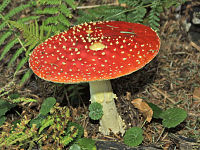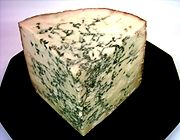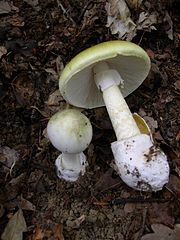Fungus
| Fungi Fossil range: Early Silurian - Recent | ||||
|---|---|---|---|---|
 | ||||
| Scientific classification | ||||
| ||||
| Divisions | ||||
|
Chytridiomycota |
Human uses of fungi
Fungi have a long history of use by humans. Many types of mushrooms and other fungi are eaten, including button mushrooms, shiitake mushrooms, and oyster mushrooms. Of course, many species of mushrooms are poisonous and are responsible for numerous cases of sickness and death every year. A type of single-celled ascomycete fungus called yeast is used in baking bread and fermenting alcoholic beverages, while mycelial fungus is used to make Shoyu (soy sauce) and tempeh. Fungi are also used to produce industrial chemicals like lactic acid, antibiotics and even to make stonewashed jeans. Some types of fungi are ingested for their psychedelic properties, both recreationally and religiously (see main article, Psychedelic mushroom).
Edible and poisonous fungi
Some of the most well-known types of fungi are the edible and poisonous mushrooms. Many species are commercially raised, but others must be harvested from the wild. Button mushrooms (Agaricus bisporus) are the most commonly eaten species, used in salads, soups, and many other dishes. Portobello mushrooms are the same species, but are allowed to grow to a much larger size. Other commercially-grown mushrooms that have gained in popularity in the West and are often available fresh in grocery stores include straw mushrooms (Volvariella volvacea), oyster mushrooms (Pleurotus ostreatus), shiitakes (Lentinula edodes), and enoki mushrooms (Flammulina spp.).
There are many more mushroom species that are harvested from the wild for personal consumption or commercial sale. Milk mushrooms, morels, chanterelles, truffles, black trumpets, and porcini mushrooms (also known as king boletes) all command a high price on the market. They are often used in gourmet dishes.
It is also a common practice to permit the growth of specific species of mold in certain types of cheeses that give them their unique flavor. This mold is non-toxic and is safe for human consumption. This accounts for the blue colour in cheeses such as Roquefort or Stilton.
Hundreds of mushroom species are toxic to humans, causing anything from upset stomachs to hallucinations to death. Some of the most deadly belong to the genus Amanita, including A. virosa (the "Destroying Angel") and A. phalloides (the "Death Cap").
Stomach cramps, vomiting, and diarrhea usually occur within 6-24 hours after ingestion of these mushrooms, followed by a brief period of remission (usually 1-2 days). Patients often fail to present themselves for treatment at this time, assuming that they have recovered. However, within 2-4 weeks liver and kidney failure leads to death if untreated. There is no antidote for the toxins in these mushrooms, but kidney dialysis and administration of corticosteroids may help. In severe cases, a liver transplant may be necessary (Kaminstein 2002). It is difficult to identify a "safe" mushroom without proper training and knowledge, thus it is often advised to assume that a mushroom in the wild is poisonous and leave it alone.
Fly agaric mushrooms (A. muscaria) are also responsible for a large number of poisonings, but these cases rarely result in death. The most common symptoms are nausea and vomiting, drowsiness, and hallucinations. In fact, this species is used ritually and recreationally for its hallucinogenic properties. However, if it is taken in over a long period of time (regularly over more than six months), this species might cause a temporary loss of sight, which can last from several minutes to an hour.
Fungi in the biological control of pests
Many fungi compete with other organisms, or directly infect them. Some of these fungi are considered beneficial because they can restrict, and sometimes eliminate, the populations of noxious organisms like pest insects, mites, weeds, nematodes and other fungi, such as those that kill plants. There is much interest on the manipulation of these beneficial fungi for the biological control of pests. Some of these fungi can be used as biopesticides, like the ones that kill insects (entomopathogenic fungi). Specific examples of fungi that have been developed as bioinsecticides are Beauveria bassiana, Metarhizium anisopliae, Hirsutella, Paecilomyces fumosoroseus, and Verticillium lecanii (=Lecanicillium lecanii ).
comments
A fungus of the species Armillaria ostoyae may be the largest organism on the planet. It was discovered in the Malheur National Forest in Oregon, and its underground mycelial network covers an area of 8.9 km² (2200 acres)[1]. Whether or not this is an actual individual organism is disputed: some tests have indicated that they have the same genetic makeup [2], but this does not exclude its being a clonal colony of numerous smaller individuals.
Notes
- ↑ The Humongous Fungus--Ten Years Later at the University of Wisconsin, Department of Botany. Accessed 20 August 2005.
- ↑ Beale, Bob. 10 April 2003. Humungous fungus: world's largest organism? at Environment & Nature News, ABC Online. Accessed 20 August 2005.
References
- Deacon JW. (2005). Fungal Biology (4th ed). Malden, MA: Blackwell Publishers. ISBN 1-4051-3066-0.
- Kaminstein D. (2002). Mushroom poisoning.
External links
- The WWW Virtual Library: Mycology
- MykoWeb: Mycological Links
- MushroomExpert.com
- MykoWeb
- Tom Volk's Fungi
- Illinois Mycological Association Mycological Glossary
- "Introduction to the Fungi", University of California Museum of Paleontology.
- Fungal Biology, University of Sydney, School of Biological Sciences, June, 2004. – Online textbook
- The Fifth Kingdom – Online textbook
- Australian National Botanic Gardens Fungi Web Site – Online textbook
- Pacific Northwest Fungi, Online Journal
- North American Mycological Society
- Mycological Society of America
- British Mycological Society
- Sydney Fungal Studies Group
- fungi as mycobionts in lichens
- CABI Bioscience Databases - Includes Index Fungorum genus and species names and top-down hierarchy
[[Category:Fungi|] Template:Link FA
ar:فطر ast:Fungi zh-min-nan:Ko͘ bg:Гъби bn:ব্যাঙের ছাতা ca:Fong cs:Houby cy:Ffwng da:Svampe de:Pilze eo:Fungo es:Fungi et:Seened fi:Sienet fr:Mycota ga:Fungas he:פטריות hr:Gljive hu:Gomba id:Fungi it:Fungi ja:菌類 ko:균류 la:Fungi lb:Pilzeräich lt:Grybų karalystė lv:sēnes mk:Габа ms:Kulat nds:Poggenstöhl nl:Schimmels no:Sopper pl:Grzyby pt:Fungos ro:Regn Fungi ru:Грибы scn:Funci simple:Fungus sv:Svampar ta:பூஞ்சைகள் th:เห็ดรา tr:Mantar wa:Tchampion zh:真菌

